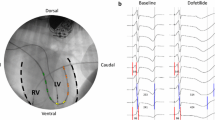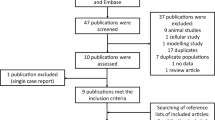Abstract
Increased proarrhythmia in dogs with chronic AV block (AVB) has been explained by ventricular remodeling causing a decrease in repolarization reserve. Beat–to–beat variability of repolarization (BVR) has been suggested to reflect repolarization reserve, in which high variability represents diminished reserve and larger propensity for repolarization–dependent ventricular arrhythmia. A subset of chronic AVB dogs (10%) suffers sudden cardiac death (SCD). With the assumption that repolarization defects constitute a potentially lethal proarrhythmic substrate, we hypothesized that BVR in SCD dogs are larger than in matched control chronic AVB dogs.
From a population of 200 chronic AVB dogs, initially two groups were chosen retrospectively: 8 dogs that died suddenly (SCD) and 8 control dogs. Control dogs had a longer lifespan after AVB (10 to 18 weeks) than SCD dogs (5 to 10 weeks). All dogs had undergone electrophysiological testing under anesthesia where ECG, left and right ventricular endocardial monophasic action potentials (MAP) were recorded. BVR was assessed from 30 consecutive beats, illustrated by Poincaré plots and was the only parameter discriminating between SCD and control group. All other electrophysiological parameters (RR, QT and MAP durations) were comparable for the two groups. Extending the number of animals and groups confirmed a larger BVR in the SCD group (SCD: 5.1 ± 2.7; n = 11 versus control: 2.5 ± 0.4 ms; n = 61; P < 0.05) and showed reverse–use dependence of BVR. In comparison, dogs with acute AVB had low variability (1.3 ± 0.3 ms; n = 9; P < 0.05 versus chronic AVB).
Cardiac electrical remodeling after AVB is associated with an increase in beat–to–beat variability of repolarization. Chronic AVB dogs displaying further elevated variability of repolarization are prone to arrhythmia–related SCD.
Similar content being viewed by others
Abbreviations
- AVB:
-
= atrioventricular block
- BVR:
-
= beat–to–beat variability of repolarization
- CL:
-
= cycle length
- ΔMAPD:
-
= interventricular dispersion of repolarization
- LV:
-
= left ventricle
- MAP:
-
= monophasic action potential
- MAPD:
-
= monophasic action potential duration
- QTc:
-
= heart–rate corrected QT interval
- QTVI:
-
= QT variability index
- RV:
-
= right ventricle
- SCD:
-
= sudden cardiac death
- STV:
-
= short–term variability
- TdP:
-
= torsades de pointes arrhythmias
References
Antzelevitch C, Shimizu W (2002) Cellular mechanisms underlying the long QT syndrome. Curr Opin Cardiol 17:43–51
Atiga WL, Calkins H, Lawrence JH, Tomaselli GF, Smith JM, Berger RD (1998) Beat-to-beat repolarization lability identifies patients at risk for sudden cardiac death. J Cardiovasc Electrophysiol 9:899–908
Berger RD, Kasper EK, Baughman KL, Marban E, Calkins H, Tomaselli GF (1997) Beat-to-beat QT interval variability: novel evidence for repolarization lability in ischemic and nonischemic dilated cardiomyopathy. Circulation 96:1557–1565
de Groot SH, Schoenmakers M, Molenschot MM, Leunissen JD, Wellens HJ, Vos MA (2000) Contractile adaptations preserving cardiac output predispose the hypertrophied canine heart to delayed afterdepolarization-dependent ventricular arrhythmias. Circulation 102:2145–2151
Di Diego JM, Sun ZQ, Antzelevitch C (1996) I(to) and action potential notch are smaller in left vs. right canine ventricular epicardium. Am J Physiol 271:H548–H561
Gorgels AP, Gijsbers C, de Vreede- Swagemakers J, Lousberg A, Wellens HJ (2003) Out-of-hospital cardiac arrest – the relevance of heart failure. The Maastricht Circulatory Arrest Registry. Eur Heart J 24:1204–1209
Hohnloser SH, Klingenheben T, Li YG, Zabel M, Peetermans J, Cohen RJ (1998) T wave alternans as a predictor of recurrent ventricular tachyarrhythmias in ICD recipients: prospective comparison with conventional risk markers. J Cardiovasc Electrophysiol 9:1258–1268
Hondeghem LM, Carlsson L, Duker G (2001) Instability and triangulation of the action potential predict serious proarrhythmia, but action potential duration prolongation is antiarrhythmic. Circulation 103:2004–2013
Huikuri HV, Makikallio TH, Raatikainen MJ, Perkiomaki J, Castellanos A, Myerburg RJ (2003) Prediction of sudden cardiac death: appraisal of the studies and methods assessing the risk of sudden arrhythmic death. Circulation 108:110- 115
Josephson M, Wellens HJ (2004) Implantable defibrillators and sudden cardiac death. Circulation 109:2685–2691
Kozhevnikov DO, Yamamoto K, Robotis D, Restivo M, El Sherif N (2002) Electrophysiological mechanism of enhanced susceptibility of hypertrophied heart to acquired torsade de pointes arrhythmias: tridimensional mapping of activation and recovery patterns. Circulation 105:1128–1134
Myerburg RJ, Interian A Jr, Mitrani RM, Kessler KM, Castellanos A (1997) Frequency of sudden cardiac death and pro- files of risk. Am J Cardiol 80:10F–19F
Ramakers C, Vos MA, Doevendans PA, Schoenmakers M, Wu YS, Scicchitano S, Iodice A, Thomas GP, Antzelevitch C, Dumaine R (2003) Coordinated downregulation of KCNQ1 and KCNE1 expression contributes to reduction of I(Ks) in canine hypertrophied hearts. Cardiovasc Res 57:486–496
Roden DM (1998) Taking the “idio” out of “idiosyncratic”: predicting torsades de pointes. Pacing Clin Electrophysiol 21:1029–1034
Rosenbaum DS, Jackson LE, Smith JM, Garan H, Ruskin JN, Cohen RJ (1994) Electrical alternans and vulnerability to ventricular arrhythmias. N Engl J Med 330:235–241
Schoenmakers M, Ramakers C, van Opstal JM, Leunissen JD, Londono C, Vos MA (2003) Asynchronous development of electrical remodeling and cardiac hypertrophy in the complete AV block dog. Cardiovasc Res 59:351–359
Schreiner KD, Voss F, Senges JC, Becker R, Kraft P, Bauer A, Kelemen K, Kuebler W, Vos MA, Schoels W (2004) Tridimensional activation patterns of acquired torsade-de-pointes-tachycardias in dogs with chronic AV-block. Basic Res Cardiol 99:288–298
Senges JC, Sterns LD, Freigang KD, Bauer A, Becker R, Kubler W, Schoels W (2000) Cesium chloride induced ventricular arrhythmias in dogs: three-dimensional activation patterns and their relation to the cesium dose applied. Basic Res Cardiol 95:152–162
Shimizu W, McMahon B, Antzelevitch C (1999) Sodium pentobarbital reduces transmural dispersion of repolarization and prevents torsades de Pointes in models of acquired and congenital long QT syndrome. J Cardiovasc Electrophysiol 10:154–164
Sipido KR, Volders PG, de Groot SH, Verdonck F, Van de Werf F, Wellens HJ, Vos MA (2000) Enhanced Ca(2+) release and Na/Ca exchange activity in hypertrophied canine ventricular myocytes: potential link between contractile adaptation and arrhythmogenesis. Circulation 102:2137–2144
Thomas GP, Vos MA, Antzelevitch C (2001) The effect of volume overload hypertrophy on transmural distribution of the delayed rectifier (IKr and IKs) and transient outward (Ito) currents in the canine heart (Abstract). Pacing Clin Electrophysiol 24:234
Thomsen MB, Verduyn SC, Stengl M, Beekman JD, de Pater G, Van Opstal JM, Volders PG, Vos MA (2004) Increased short-term variability of repolarization predicts d-sotalol-induced torsades de pointes in dogs. Circulation 110:2453–2459
Thomsen MB, Volders PG, Stengl M, Spätjens RL, Beekman JD, Bischoff U, Kall MA, Frederiksen K, Matz J, Vos MA (2003) Electrophysiological safety of sertindole in dogs with normal and remodeled hearts. J Pharmacol Exp Ther 307:776–784
Van de Water A, Verheyen J, Xhonneux R, Reneman RS (1989) An improved method to correct the QT interval of the electrocardiogram for changes in heart rate. J Pharmacol Methods 22:207–217
van Opstal JM, Leunissen JD, Wellens HJ, Vos MA (2001) Azimilide and dofetilide produce similar electrophysiological and proarrhythmic effects in a canine model of Torsade de Pointes arrhythmias. Eur J Pharmacol 412:67–76
van Opstal JM, Verduyn SC, Leunissen HDM, de Groot SHM, Wellens HJJ, Vos MA (2001) Electrophysiological parameters indicative of sudden cardiac death in the dog with chronic complete AV-block. Cardiovascular Research 50:354–361
Verduyn SC, Ramakers C, Snoep G, Leunissen JD, Wellens HJ, Vos MA (2001) Time course of structural adaptations in chronic AV block dogs: evidence for differential ventricular remodeling. Am J Physiol Heart Circ Physiol 280:H2882–H2890
Verduyn SC, Vos MA, van der Zande J, Kulcsar A, Wellens HJ (1997) Further observations to elucidate the role of interventricular dispersion of repolarization and early afterdepolarizations in the genesis of acquired torsade de pointes arrhythmias: a comparison between almokalant and d-sotalol using the dog as its own control. J Am Coll Cardiol 30:1575–1584
Volders PG, Sipido KR, Carmeliet E, Spatjens RL, Wellens HJ, Vos MA (1999) Repolarizing K+ currents ITO1 and IKs are larger in right than left canine ventricular midmyocardium. Circulation 99:206–210
Volders PG, Sipido KR, Vos MA, Kulcsar A, Verduyn SC, Wellens HJ (1998) Cellular basis of biventricular hypertrophy and arrhythmogenesis in dogs with chronic complete atrioventricular block and acquired torsade de pointes. Circulation 98:1136–1147
Volders PG, Sipido KR, Vos MA, Spatjens RL, Leunissen JD, Carmeliet E, Wellens HJ (1999) Downregulation of delayed rectifier K(+) currents in dogs with chronic complete atrioventricular block and acquired torsades de pointes. Circulation 100:2455–2461
Volders PG, Stengl M, van Opstal JM, Gerlach U, Spatjens RL, Beekman JD, Sipido KR, Vos MA (2003) Probing the contribution of IKs to canine ventricular repolarization: key role for beta-adrenergic receptor stimulation. Circulation 107:2753–2760
Vos MA, de Groot SH, Verduyn SC, van der Zande J, Leunissen HD, Cleutjens JP, van Bilsen M, Daemen MJ, Schreuder JJ, Allessie MA, Wellens HJ (1998) Enhanced susceptibility for acquired torsade de pointes arrhythmias in the dog with chronic, complete AV block is related to cardiac hypertrophy and electrical remodeling. Circulation 98:1125–1135
Yamamoto K, Tamura T, Imai R, Yamamoto M (2001) Acute canine model for drug-induced Torsades de Pointes in drug safety evaluation-influences of anesthesia and validation with quinidine and astemizole. Toxicol Sci 60:165–176
Zipes DP, Wellens HJ (1998) Sudden cardiac death. Circulation 98:2334–2351
Author information
Authors and Affiliations
Corresponding author
Additional information
Mr. Thomsen and Dr. Truin contributed equally to this study
Rights and permissions
About this article
Cite this article
Thomsen, M.B., Truin, M., van Opstal, J.M. et al. Sudden cardiac death in dogs with remodeled hearts is associated with larger beat–to–beat variability of repolarization. Basic Res Cardiol 100, 279–287 (2005). https://doi.org/10.1007/s00395-005-0519-6
Received:
Revised:
Accepted:
Published:
Issue Date:
DOI: https://doi.org/10.1007/s00395-005-0519-6




